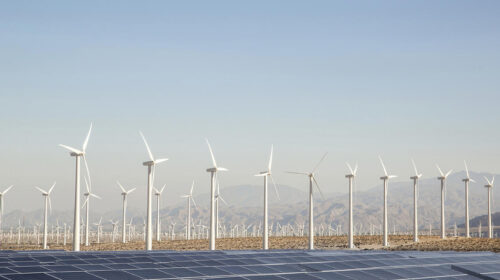Renewable energy power plants continue to dominate new power capacity additions in the United States. In December, approximately 80% of new power capacity in the country came from renewables, following an even bigger month of November in which the split was 90% for renewables. For the full year, renewables accounted for 83–84% of new power capacity.
As you can see in the charts below, solar power has been the leading source of new power capacity in the past year. If you count small solar power projects and large solar power projects separately, wind led the way in November, but even large solar power plants alone took the #1 position in December and throughout the whole year.
Aside from solar and wind power, only one other electricity source is worth mentioning — “natural gas,” which we think is better labeled “fossil gas.” Fossil gas power plants accounted for 10% of new power capacity in November, 20% in December, and 16% across all of 2021.
This is a big shift from prior years, in which natural gas was a much larger share of new power capacity. New power capacity from “natural gas” took a big step down from 2019 to 2020, but then it took an even bigger step down from 2020 to 2021. The largest source of power stepping up to take over its losses has been solar power.
Total US Power Capacity by Source
The above charts and data cover new power capacity. Total US power capacity is a different matter. It takes a long time to retire power plants and replace them with new ones. Thus, renewable energy’s share of total power capacity always looks much worse than renewable energy’s share new power capacity.
At the end of 2021, renewables accounted for about 26% of total power capacity in the United States. That’s up from approximately 22% at the end of 2019 and 24% at the end of 2020, but growth of 2 percentage points a year is not especially inspiring when we consider the climate crisis we have on our hands due to burning of fossil fuels across the US and the world.
Of that December 2021 total, wind and solar accounted for 16%, up from 12% in December 2019 and 14% in December 2020.
As the charts above and below make evident, there’s still and enormous amount of coal and fossil gas power capacity on the grid, not to mention oil. (Yes, oil is used for electricity production in some regions of the country). Coal was at 18.5% of power capacity in December 2020, while fossil gas was at 44.2%. That’s down from 20.9% and 44.7%, respectively, in December 2019.
It’s a notable transition, but it’s a much slower one when you look at total installed capacity instead of new installed capacity.
For more fun, you can explore the interactive charts below by hovering over them.
Also see: Renewable Energy Provided 24% Of US Electricity In DecemberAppreciate CleanTechnica’s originality? Consider becoming a CleanTechnica Member, Supporter, Technician, or Ambassador — or a patron on Patreon.













